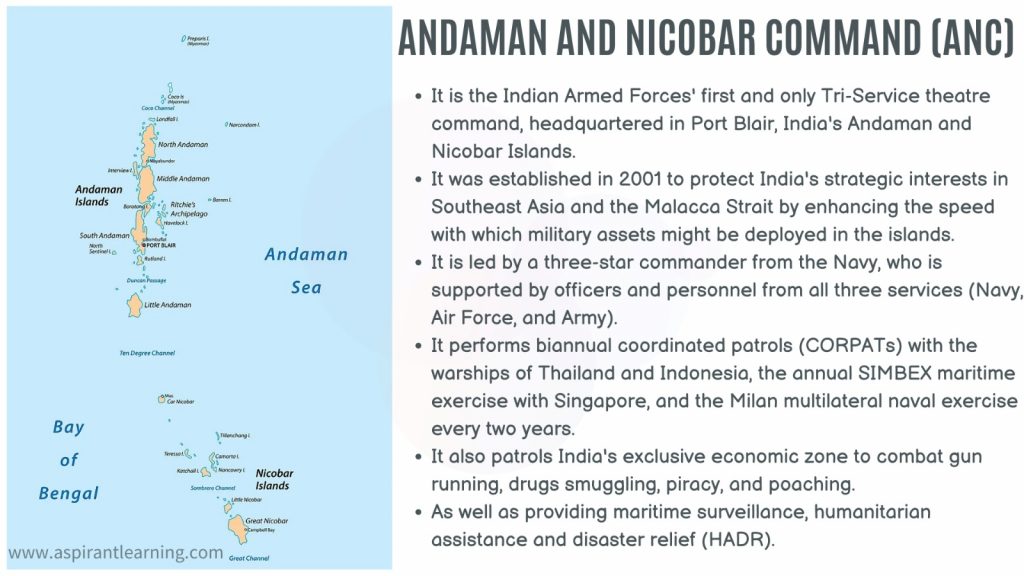News Highlight
The Inter-Services Organisation Bill, which the Junior defence minister introduced in 2023 in Lok Sabha.
Key Takeaway
- A bill to empower the government to form inter-services organisations lays the groundwork for establishing an integrated theatre command in the country.
- It was introduced in Parliament on March 15 and gave their commanders disciplinary and administrative powers.
The Inter-Services Organisation Bill, 2023
- Current Procedure
- The laws of the Air Force Act, 1950, the Army Act, 1950, and the Navy Act, 1957 govern the service personnel of the Indian Air Force, Army, and Navy, respectively.
- Under present rules and regulations, only officers of the respective services are authorised.
- In addition, it is to exercise disciplinary powers over service personnel under the respective service Acts.
- The Commander-in-Chief of an interservice organisation is not authorised to exert disciplinary or administrative authority over personnel from other services.
- Salient Features of The Bill
- It includes giving the central government the authority to form inter-service organisations through notification.
- It may include a joint services command comprised of units or troops under the Air Force Act of 1950, the Army Act of 1950, and the Navy Act of 1957.
- The bill also seeks to empower the commander-in-chief, officer-in-command, or any other officer.
- The central government specially empowers them with all disciplinary and administrative powers.
- The concerning personnel in or attached to their inter-services organisations.
- Regardless of service, to maintain discipline and properly discharge their duties.
- The proposed legislation will also open the way for various additional practical benefits, such as;
- Expedited case disposition
- Time and public money savings by avoiding repeated hearings
- Increased integration
- Joint manship among armed forces employees.
- The bill’s stalling coincides with the government’s ambitious theaterisation plan.
Integrated Theatre Command (Theaterisation)
- About
- The concept of Theatre Command was proposed in the findings of the military reforms committee.
- Lt General chaired it (ret.) DB Shekatkar.
- It proposed the formation of three integrated theatre commands:
- One in the north for the Chinese border
- One in the west for the Pakistan border
- One in the south for the sea role.
- It permits the coordination of resources from all three services under a single commander to secure a certain geographical area.
- A theatre will be identified by sharing a contiguous geographical boundary with a competitive entity or an adversary.
- The geographical area must also encompass adjacent oceans and space.
- They may be required to manoeuvre their forces to handle the threatening entity/adversary and its geographically nearby collaborators.
- The commander of a Theatre Command will not be beholden to any specific Service.
- They will have access to all Tri-Service resources.
- The integrated theatre commander will be free to train, equip, and exercise his command.
- It is to create a coherent combat force capable of attaining specific objectives.
- Furthermore, the commander will have access to all logistical resources needed to assist his activities.
- The concept of Theatre Command was proposed in the findings of the military reforms committee.
Challenges of Theaterisation
- Certain strategic and tactical obstacles, such as deploying specialised resources, may exist.
- They are restricted in quantity, such as multi-role combat aircraft, command, control, communication systems, early warning assets, etc.
- The division of such meagre resources will impair battle efficiency at the decision point.
- These resources will also have to be reproduced for each theatre command.
- Doing so will be prohibitively expensive, especially given the country’s current economic situation.
- Furthermore, during a battle, the interoperability of personnel and equipment from dormant sectors.
- It is to active ones will be difficult and ineffective.
- It is because they would have been specifically trained and equipped for their principal area of responsibility.
- Another significant difficulty that may be encountered is that the concept of a theatre command may foster a mentality of “fighting battles rather than fighting wars,”.
- It may decrease our potential to win a battle or a war.
Current Command Structure in India
- The military system contains 17 distinct commands.
- The Army and Air Force each have seven commands, with the Navy commanding three.
- Northern, Southern, Eastern, Western, Central, Southwestern, Central, and Maintenance and Training commands are part of the Army.
- The Navy is divided into three commands:
- Western
- Eastern
- Southern
- A four-star military commander leads each command.
- In addition, there are just two tri-service commands in India.
- The Andaman and Nicobar Command (ANC) was first established in 2001.
- It is led on a rotating basis by service chiefs.
- Furthermore, the second is the Strategic Forces Command, established in 2006 as an available command.

Pic Courtesy: freepik
Content Source: Times of India



